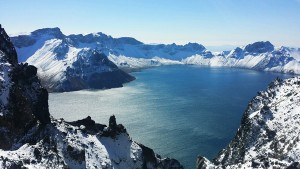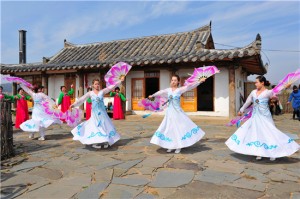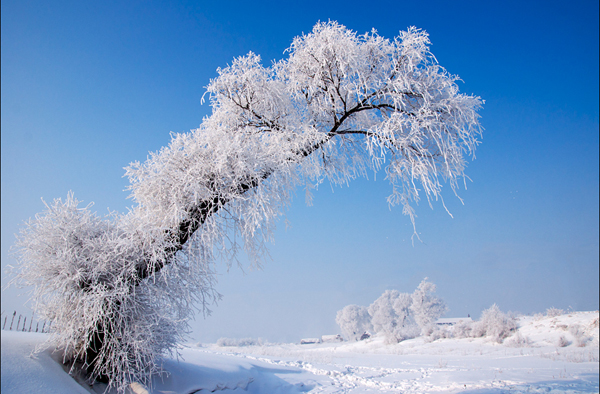Compared to popular provinces like Jiangsu and Yunnan, Jilin is still relatively unknown when it comes to tourism in China. Yet scratch beneath its icy surface, and you’ll find a wealth of stunning attractions just waiting to be discovered! Jilin is located in a northeastern region of China that was formerly known as Manchuria. Historically this region frequently found itself outside of Han Chinese rule, meaning its culture is far more diverse than other parts of China. From the Koreans of the Goguryeo Kingdom (37 BC–668 AD) and the Khitans of the Liao Dynasty (907–1125) to the Jurchens of the Jin Dynasty (1115–1234), Jilin’s history is a patchwork of cultures and ethnicities.
In terms of climate, Jilin may be more temperate than its northerly neighbours, but it still suffers from lengthy and bitterly cold winters. During the winter months, temperatures regularly drop to an average of −17 °C (2 °F), and only rise to around 23 °C (74 °F) in summer. Snow arrives as early as October and can last until April, making the province a veritable winter wonderland! For this reason, Jilin is a popular haven for winter sports and boasts a number of fabulous ski resorts. Although not as popular as its counterpart in Harbin of Heilongjiang province, the Ice Lantern Festival in the city of Jilin is another charming example of the superlative winter tourism that this province has to offer.
 In the east, the snowy Changbai Mountains represent one of the most famous mountain ranges in China and are partially shared with North Korea. The mountains are considered sacred to both the Korean and the Manchu people. In the eastern region of the mountain range, the ethereal Heaven Lake sits like a deep blue sapphire set into the mountaintop. It’s important to note that this spectacular volcanic lake is split between China and North Korea, so visitors can only enjoy the view from the Chinese side. The shimmering Changbai Waterfall is equally as magnificent, and acts as the source of the Songhua River. Not to mention, there are plenty of hot springs along the mountain range where weary hikers can enjoy a much-needed soak!
In the east, the snowy Changbai Mountains represent one of the most famous mountain ranges in China and are partially shared with North Korea. The mountains are considered sacred to both the Korean and the Manchu people. In the eastern region of the mountain range, the ethereal Heaven Lake sits like a deep blue sapphire set into the mountaintop. It’s important to note that this spectacular volcanic lake is split between China and North Korea, so visitors can only enjoy the view from the Chinese side. The shimmering Changbai Waterfall is equally as magnificent, and acts as the source of the Songhua River. Not to mention, there are plenty of hot springs along the mountain range where weary hikers can enjoy a much-needed soak!
Alongside the Changbai Mountains, the province is celebrated for its myriad of scenic nature reserves, such as Jingyue Lake National Forest Park and Xinghai National Nature Reserve. From verdant seas of lush trees to sparkling pools of crystal clear water, these reserves are the ideal place to escape the city and embrace the beauty of nature. If you’re lucky, you may even catch a glimpse of the Ice-Rimmed Trees, which are considered one of China’s Four Major Natural Wonders.
This icy spectacle only lasts from January to February, when warm water from the Songhua River evaporates and freezes in the cold winter air to form delicate ice crystals that hang from the trees lining the riverbed. It can only be viewed in the early morning, as the ice largely melts after 7am, so be prepared for an early start if you want to admire this frosty phenomenon!
With the province’s unusual history, it should come as no surprise that its superb historical attractions are as numerous as its natural ones. Wandu Mountain City and Guonei City were both imperial capitals of the Korean Goguryeo Kingdom, and were collectively designated a UNESCO World Heritage Site in 2004. These ancient mountain fortresses contain the ruins of watchtowers, imperial tombs, city walls, and various buildings that act as a testament to the province’s multi-ethnic past.
 Similarly, the Ancient Tombs at Longtou Mountain house the burial sites of some twelve royal figures belonging to the Korean Balhae Kingdom (698–926). These tombs are located in the Yanbian Korean Autonomous Prefecture, which is populated by the largest concentration of ethnic Koreans in China. While some of these are expatriates, many of them were born in China, hold Chinese citizenship, and speak Mandarin Chinese as well as Korean. The prefecture itself is an excellent place to experience traditional Korean culture with a Chinese twist.
Similarly, the Ancient Tombs at Longtou Mountain house the burial sites of some twelve royal figures belonging to the Korean Balhae Kingdom (698–926). These tombs are located in the Yanbian Korean Autonomous Prefecture, which is populated by the largest concentration of ethnic Koreans in China. While some of these are expatriates, many of them were born in China, hold Chinese citizenship, and speak Mandarin Chinese as well as Korean. The prefecture itself is an excellent place to experience traditional Korean culture with a Chinese twist.
Arguably the most intriguing historical attraction that the province has to offer is the Museum of the Imperial Palace of the Manchu State, more commonly known as the “Puppet Emperor’s Palace”. It’s located in the provincial capital of Changchun and boasts a plethora of gorgeous sights, including gardens, swimming pools, and luxurious palace buildings. Its architecture is an elegant mixture of Western and traditional Chinese features.
After the Qing Dynasty (1644-1912) collapsed, the Japanese government seized control of northeast China in 1931, renamed it Manchukuo, and set the last Qing Emperor, Puyi, on the throne as its puppet emperor. This palace served as his home from that time right up until the fall of Manchukuo in 1945. Although it suffered a huge amount of damage during the fall, it has since been restored and is now a museum, where visitors can admire the palace architecture and view exhibitions of the Emperor’s photographs, papers, and belongings. After all, if you can’t live the royal life, you might as well get a taste of it!
